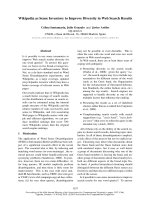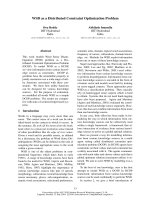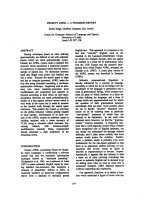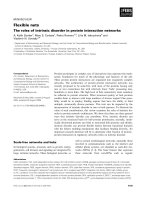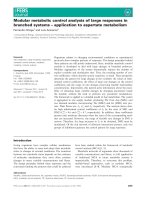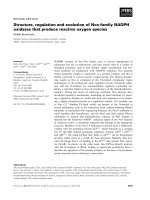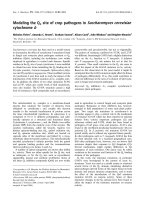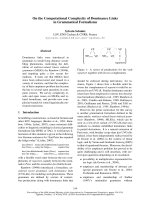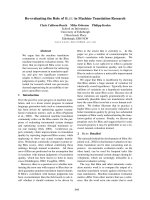báo cáo khoa học: "Pyosalpinx as a sequela of labial fusion in a post-menopausal woman: a case report" pptx
Bạn đang xem bản rút gọn của tài liệu. Xem và tải ngay bản đầy đủ của tài liệu tại đây (810.63 KB, 14 trang )
This Provisional PDF corresponds to the article as it appeared upon acceptance. Fully formatted
PDF and full text (HTML) versions will be made available soon.
Pyosalpinx as a sequela of labial fusion in a post-menopausal woman: a case
report
Journal of Medical Case Reports 2011, 5:546 doi:10.1186/1752-1947-5-546
George I Tsianos ()
Stefania I Papatheodorou ()
George M Michos ()
George Koliopoulos ()
Theodore Stefos ()
ISSN 1752-1947
Article type Case report
Submission date 26 May 2011
Acceptance date 6 November 2011
Publication date 6 November 2011
Article URL />This peer-reviewed article was published immediately upon acceptance. It can be downloaded,
printed and distributed freely for any purposes (see copyright notice below).
Articles in Journal of Medical Case Reports are listed in PubMed and archived at PubMed Central.
For information about publishing your research in Journal of Medical Case Reports or any BioMed
Central journal, go to
/>For information about other BioMed Central publications go to
/>Journal of Medical Case
Reports
© 2011 Tsianos et al. ; licensee BioMed Central Ltd.
This is an open access article distributed under the terms of the Creative Commons Attribution License ( />which permits unrestricted use, distribution, and reproduction in any medium, provided the original work is properly cited.
Pyosalpinx as a sequela of labial fusion in a post-menopausal woman: a
case report
George I Tsianos, Stefania I Papatheodorou, George M Michos, George
Koliopoulos*, Theodor Stefos
Address: Department of Obstetrics and Gynecology, University of Ioannina
School of Medicine, Ioannina 45110, Greece.
*Corresponding author
GIT:
SIP:
GMM:
GK:
TS:
Abstract
Introduction: Complete labia fusion is a rare clinical identity in post-menopausal
women. The most common complications of this presentation are infections of
the urinary tract and retention of urine in the vagina. We present the case of a
post-menopausal woman with adnexal mass and abdominal pain due to fusion of
the labia majora. To the best of our knowledge this is the first report in the
literature of this complication.
Case presentation: A 78-year-old Caucasian woman was admitted to our
hospital due to abdominal pain and urination difficulty, along with fever and
leucocytosis. On examination the labial majora were fused. Computed
tomography of the abdomen revealed a cystic formation in the anatomical area of
the right adnexa. Our patient had developed a pyosalpinx as a Sequela of labial
fusion. At laparoscopy the right pyosalpinx was identified and resected, whereas
the labia majora were reconstructed via dissection and separation.
Conclusions: Labial fusion is a rare clinical identity in post-menopausal women
and can have serious and unexpected complications. Though this presentation is
rare, a clinical examination must be performed in detail in order to gain valuable
information for an accurate diagnosis. Post-operational instruction must be given
to patients in order to prevent the re-occurrence of the fusion and its
complications.
Introduction
Labial fusion in adults is a rare clinical entity with only few described cases, in
particular in post-menopausal women. The major symptom in those reported
cases is urination anomalies and most commonly infections of the urinary tract.
Pyosalpinx is most often a complication of pelvic inflammatory disease arising
from a variety of causes. In post-menopausal women, pyosalpinx is commonly
associated with primary fallopian tube malignancy. We report a case of a post-
menopausal woman who developed a pyosalpinx following complete fusion of
the labial majora.
Case presentation
A 78-year-old Caucasian Greek post-menopausal woman was admitted to our
hospital due to continuous pain in her lower abdomen along with fever. Both
symptoms began one week prior to admission and had become progressively
worse over the 24 hours before presentation when she experienced four vomiting
episodes. Our patient reported a long-standing history of urinary incontinence
and voiding difficulty.
Her overall clinical examination did not reveal anything worrisome, although a
gynecological examination was unfeasible due to complete labial majora fusion
(Figure 1). There was no visible opening that would allow urination, although our
patient mentioned being constantly wet. Our patient recalled a similar labial
fusion in the past, which had been surgically treated six years previously;
unfortunately neither the records nor the means of treatment were available from
her previous hospital admission. Her medical history revealed coronary heart
disease and type II diabetes mellitus. She had been a widow for over 20 years,
and claimed to have had no sexual relationships since her husband’s death.
Laboratory blood analysis on admission revealed the following: leucocytosis
(white blood cell (WBC) count 13.02×109/L) with neutrophilia (neutrophils
11.95×109/L) with a further rise on day two (WBC: 18.64×109/L) followed by a
drop on day four (WBC: 12.82×109/L); an elevated C-reactive protein level
(105mg/L) with a further rise on day two (119mg/L) followed by a drop on day
four (59mg/L); an elevated blood glucose level (165mg/dL) followed by a drop on
day two (142mg/L) and then the level remained within normal limits throughout
the rest of her hospital stay and finally an elevated lactate dehydrogenase level
(286U/L). Carcinoembryonic antigen (CEA), α-fetoprotein (AFP), β-human
chorionic gonadotropin (β-HCG), cancer antigen 125 (CA 125), cancer antigen
19.9 (CA 19.9) and cancer antigen 15.3 (CA 15.3) levels were all normal. Serum
urea, creatinine, sodium and potassium levels were within normal limits. A
computed tomography (CT) scan of her abdomen on admission showed a cystic
(7×4.5cm) formation within the pelvis minor in the anatomical position of the right
adnexa; the formation appeared to be tubular in shape most likely suggesting a
hydrosalpinx or pyosalpinx.
After assessing all available evidence we were led to believe that our patient had
most likely developed a pyosalpinx as a complication of the labial majora fusion.
Our patient was started on antibiotic treatment. Three days later she underwent a
minor surgical procedure during which a small opening was made in the outer
vulvar lips in order to assist urination. Following antibiotic treatment there was
resolution of her symptoms and, as our patient was judged to be at high risk if
placed under general anesthesia, a conservative treatment of the pyosalpinx was
preferred. A week later our patient was discharged and an appointment for a
follow-up visit was made in two weeks. During the scheduled appointment a
decision would be made on whether to proceed to labial separation alone or
combined abdominal surgical treatment of the pyosalpinx.
On arrival for the follow-up visit her blood test results were normal except for her
blood glucose (174mg/dL) and lactate dehydrogenase (257U/L) levels. Her CEA,
AFP, CA 125, CA 19.9 and CA 15.3 levels were normal; β-HCG however was
mildly elevated. A second CT scan of the abdomen confirmed persistence of the
previous pyosalpinx finding. Furthermore, a 7cm elongated cystic formation
suggestive of a cystovaginal fistula was identified, as well as bilateral mild
hydronephrosis as a result of the urinary bladder’s over-distension.
On day two of admission our patient underwent laparoscopic surgery during
which the right pyosalpinx was identified and subsequently resected (Figure 2),
and in the end the labia majora were reconstructed via blunt labial dissection and
separation (Figure 3). During the operation, we also identified accumulation of a
large amount of urine in the vagina, suggestive of urocolpos, which was
observed on the CT scan but no signs of a urinary fistula were seen. Our patient
was discharged two days later without any problems or complications. Five
months following the procedure our patient is on regular follow-up without any
symptoms. She has been advised to regularly use vaginal dilators and courses of
local estrogen treatment.
The pathology report from the tissue specimens retrieved from the operation
showed acute and chronic inflammation in the fallopian tube mucosa and chronic
inflammation in the skin of the labia majora. No signs of malignancy were found
in either of the fallopian tubes or the labia majora.
Discussion
Pyosalpinx following labial fusion has not been reported previously in the
literature and, to the best of our knowledge, this is the first case report of such
Sequela. Labial fusion occurs mainly in the first years of life and can be
congenital or acquired. The condition is rare in adults and only a few cases have
been reported in the literature, predominantly in post-menopausal women. The
pathophysiological mechanism is believed to be chronic inflammation and/or
irritation of the vulvar skin arising from various conditions such as local
inflammation [1], lichen sclerosus [2], recurrent urinary tract infections [3] as well
as lack of sexual activity, lack of estrogen and local trauma. The major
presenting symptom is urinary incontinence [1, 4, 5] and voiding dysfunction [6,
7] whereas the mechanism by which this occurs is most likely due to physical
obstruction of the urinary flow, directly related to the labial fusion. In addition, the
mechanical obstruction of urine flow commonly results in a retrograde flow inside
the vaginal cavity, forming a urocolpos and thus ultimately leading to urination
anomalies; such cases have been previously described [8, 9].
Our patient had been previously diagnosed with labial fusion and although she
recalled having been surgically treated, her condition reappeared. Recurrence of
labial fusion has been previously described [10], and we assume that in our
patient, the fused labia during the first episode may not have been significantly
surgically separated. In addition, it seems that she was not given any post-
operative instruction for use of vaginal dilators and local estrogen treatment.
These instructions in our view are essential for the maintenance of a good
outcome. In our patient although there was no visible vulvar opening, it is likely
that some amount of the urine that was accumulating inside the vagina causing
urocolpos was constantly filtered through the fused labia, since our patient stated
she was continuously wet.
A pyosalpinx is one of the features of pelvic inflammatory disease and refers to
the presence of pus in one of the fallopian tubes occurring as a consequence of
an infection in the reproductive tract. Infections may start in the vagina and
progress up to the cervix, uterus and to one or both fallopian tubes. The most
notable long-term complications of this condition are tubal infertility and ectopic
pregnancy. The most common causative microorganisms are Chlamydia
trachomatis, Neisseria gonorrhea, and microorganisms associated with bacterial
vaginosis [11], although other causes have been described in the literature such
as infections by Streptococcus pneumoniae [12], coliforms [13], or even
complications during in vitro fertilization [14], and appendectomy [15].
In the present case report it is highly probable that due to the urine accumulation
in the vaginal cavity the microorganisms in the formed urocolpos ascended
through the cervix, inside the uterus and then up the fallopian tube where an
infection formed and a pyosalpinx ultimately developed. Pyosalpinx can be
treated conservatively with antibiotic treatment but surgical intervention in the
form of salpingectomy might be required; in the present case report, this was
performed laparoscopically.
Conclusions
It is clear that complete or partial labial fusion can result in urinary tract
obstruction and infection to varying degrees. Clinical identities that are not
common in a specific age or risk group should always be included in a differential
diagnosis in order to obtain a complete and effective therapeutic approach for
each patient. In this particular case, a pyosalpinx was formed not due to a pelvic
infection as may be expected in a younger and sexually active patient, but due to
mechanical obstruction of the outflow of urine. Combining all data from clinical
examination and imaging techniques can lead the physician to apply an
evidence-based therapeutic strategy.
Patient’s perspective
[Translated from the patient's native language] In one of the follow-up visits, I
was asked about my feelings regarding my problem. I mentioned that I found not
being able to urinate properly distressing and I was embarrassed to be constantly
wet. I was disappointed that the initial procedure some years ago failed and that I
had not been instructed to be under regular follow-up, nor had I been given
instructions to try and keep the vulvar introitus open. I was extremely pleased
with the outcome of the second procedure. I am happy that I am able to
completely empty my bladder and was surprised I recovered so quickly from the
laparoscopic salpingectomy. I am very willing to do whatever I am instructed to
prevent a recurrence of the fusion, and I agree to have my case shared with the
medical community if it helps other women with a similar problem.
Consent
Written informed consent was obtained from the patient for publication of this
case report and any accompanying images. A copy of the written consent is
available for review by the Editor-in-Chief of this journal.
Competing interests
The authors declare that they have no competing interests.
Authors’ contributions
GIT, SIP and GMM analyzed and interpreted the data from our patient regarding
clinical presentation, and hematological and imaging data. GK and TS performed
the first labial dissection and the operative laparoscopy. All authors contributed to
writing the manuscript and approved the final version.
Acknowledgments
There was no funding for conducting the description of this case report.
References
1. Pulvino JQ, Flynn MK, Buchsbaum GM: Urinary incontinence secondary to
severe labial agglutination. Int Urojynecol J Pelvic Floor Dysfunct 2008,
19:253-256.
2. Attaran M, Rome E, Gidwani GP: Unusual presentation of lichen sclerosuis
in an adolescent. J Pediatr Adolesc Gynecol 2000, 13:99.
3. Podolsky ML: Labial fusion: a cause of recurrent urinary tract infections.
Clin Pediatr 1973, 12:345-346.
4. Nevarez Bernal RA, Meraz Avila D: Fusion of the labia minora as a cause
of urinary incontinence in a postmenopausal woman. A case report and
literature review. Ginecol Obstet Mex 2009, 77:287-290.
5. Julia J, Yacoub M, Levy G: Labial fusion causing urinary incontinence in a
postmenopausal female: a case report. Int Urogynecol J Pelvic Floor Dysfunct
2003, 14:360-361.
6. Muppala H, Meskhi A: Voiding dysfunction due to long-standing labial
fusion in an elderly woman: a case report. Int Urogynecol J Pelvic Floor
Dysfunct 2009, 20:251-252.
7. Ong NC, Dwyer PL: Labial fusion causing voiding difficulty and urinary
incontinence. Aust NZ J Obstet Gynaecol 1999, 39:391-393.
8. Arango Toro O, Nohales Taurines G, Carreras Collado R, Bielsa Gali O,
Gelabert-Mas A: Urocolpos: a cause of pseudo-incontinence in aged women
[in Spanish]. Actas Urol Esp 1996, 20:72-77.
9. Ortega Mariscal J, Congregado Ruiz B, Campoy Martínez P, Pérez Pérez M,
Rodríguez Pérez A, Soltero González A: Urinary incontinence caused by
urocolpos. Report of a new case. Actas Urol Esp 2001, 25:450-451.
10. Purnell LW: Unusual cause of urinary obstruction. Br Med J 1969, 7:637.
11. Paavonen J: Pelvic inflammatory disease. From diagnosis to prevention.
Dermatol Clin 1998, 16:747-756.
12. Meis JF, Festen C, Hoogkamp-Korstanje JA: Pyosalpinx caused by
Streptococcus pneumoniae in a young girl. Pediatr Infect Dis J 1993, 12:539-
540.
13. Habek D, Vranko NN, Sklebar I, Grabovac S, Cerkez HJ: Rupture of
coliform pyosalpinx in a nine-year old girl. Zentralbl Gynakol 2002, 124:220-
222.
14. Kihaile P, Misumi J, Utsunomiya T: Peritonitis after a ruptured left
pyosalpinx in a patient undergoing in vitro fertilization. Fertil Steril 2003,
79:1034-1036.
15. Singh-Ranger D, Sanusi A, Hamo I: Coliform pyosalpinx as a rare
complication of appendicectomy: a case report and review of the literature
on best practice. J Med Case Reports 2008, 2:97.
Figure 1. Labial fusion: pre-operational image of labial fusion. The labia
majora are completely fused, leaving a very small opening to allow urination.
Figure 2. Dissected labia majora. Post-operative appearance of the labia after
the blunt dissection and separation.
Figure 3. Pyosalpinx. Intra-operative image of the fallopian tube during
laparoscopic resection. The pyosalpinx was removed intact.
Figure 1
Figure 2
Figure 3

